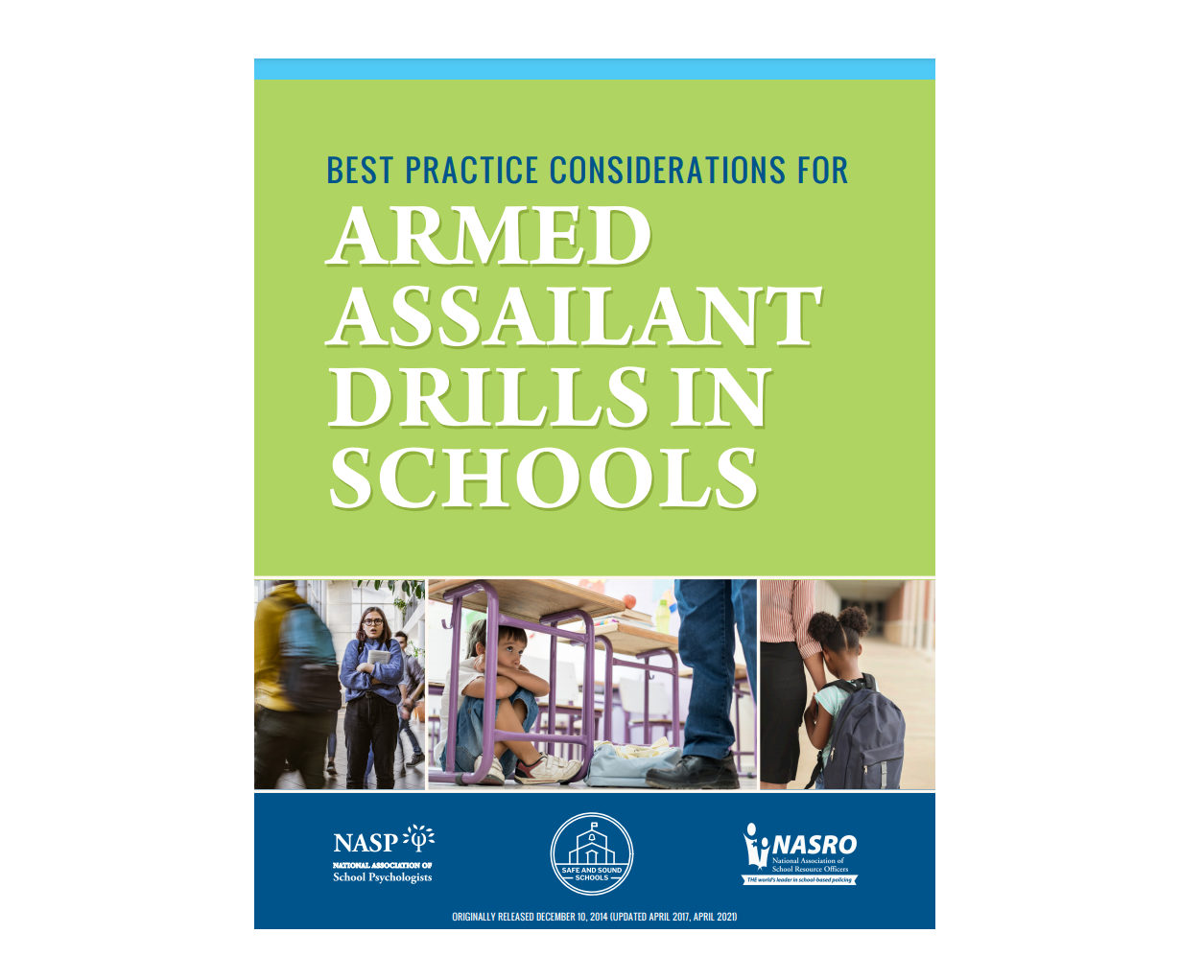Bethesda, Maryland — The National Association of School Psychologists (NASP), the National Association of School Resource Officers (NASRO), and Safe and Sound Schools (SASS) have partnered to release updated guidance on conducting armed assailant drills in schools. The author organizations represent key stakeholders in school safety and crisis planning, preparedness, and implementation. This includes school-employed mental health professionals, school security and law enforcement, school administrators, other educators, and families. We have expertise and extensive first-hand experience with the most effective approaches to keeping students and staff safe on a daily basis and in crisis situations. We are committed to supporting school communities’ understanding and implementation of best practices related to this work.
The new version of Best Practice Considerations for Armed Assailant Drills in Schools updates and builds on the guidance released by NASP and NASRO in 2014 in response to the rapid rise in the use of intensive and highly sensorial armed assailant drills following the tragic shootings at Sandy Hook Elementary School. In the years since, school districts across the country have continued to seek ways to improve prevention and preparedness related to the possibility of an armed intruder on campus. Many states have legally mandated armed assailant drills without providing much guidance, which has contributed to confusion about the differences between lockdown, options-based training, and full-scale simulation drills, as well as growing concern over the unintended harm caused by conducting drills inappropriately.
Ensuring that drills are conducted appropriately is particularly urgent as many schools across the country are returning or planning to return to in-person learning. Students and staff will be relearning safety protocols in the wake of what has been a very stressful, even traumatic, year for many individuals and school communities. It is imperative that safety drills of any kind do not unintentionally trigger or exacerbate students’ or staff sense of risk or trauma.
“While the statistical probability that a school will experience an active assailant event is extremely low, concern about the possibility is high because school shootings do continue and are devastating when they occur,” notes NASP Executive Director Kathleen Minke. “Our goal with this document is to provide school leaders and relevant emergency responders with the critical considerations to help schools determine to what extent they need armed assailant training and to conduct trainings that make best use of resources, maximize effectiveness, and minimize physical and psychological risks.”
According to Mo Canady, Executive Director for the National Association of School Resource Officers, “Armed assailant drills became much more commonplace after 15 highly publicized deadly shootings in schools in the late 1990s, culminating with the massacre at Columbine High School. We had very limited guidance on how to conduct drills related to this new phenomenon, and we certainly made many mistakes as we sought to develop plans and drills intended to keep students safe. This guidance is a culmination of lessons learned as well as a collaborative effort with a strong focus not only on the physical safety of students, but their psychological safety as well.”
The guidelines recommend that schools engage in simple discussion-based exercises before conducting drills. If and when such drills are held, schools must consider factors such as developmental maturity, psychological history, prior traumatic experiences, personality, and special needs of participants. All participants should have a chance to opt out as long as alternative preparation is provided. Additionally, participants should be notified in advance of all planned activities included in the drill. Parental permission should be required for all students. Staff should be trained to recognize common trauma signs and monitor participants during the drill, and all participants should have access to school-employed mental health professionals after the drill’s completion. The document includes a hierarchy of education and training options as well as a review of levels of developmental safety awareness.
According to Michele Gay, Sandy Hook mother and Executive Director of Safe and Sound Schools, “School communities have successfully conducted drills for fire, weather, and earthquake for decades, preparing students and staff for safety in a variety of crisis scenarios. Yet many have struggled with active assailant drills, causing avoidance, confusion, anxiety—and in some cases physical and psychological harm. With this guidance, we aim to provide a clear, practical, ‘no drama-no trauma’ approach to teaching and training students and staff for the complex threat of violence in the school setting.”
Authors also point out that any armed assailant exercises should be considered as only one component of a comprehensive approach to school safety and crisis response. Given resource realities for many schools, training should meet the specific needs of the school and community, and more intensive, full scale drills should be conducted with careful consideration of the potential costs, risks, and benefits involved. The new guidance seeks to aid schools in coming to an informed decision regarding the best approach for them.







